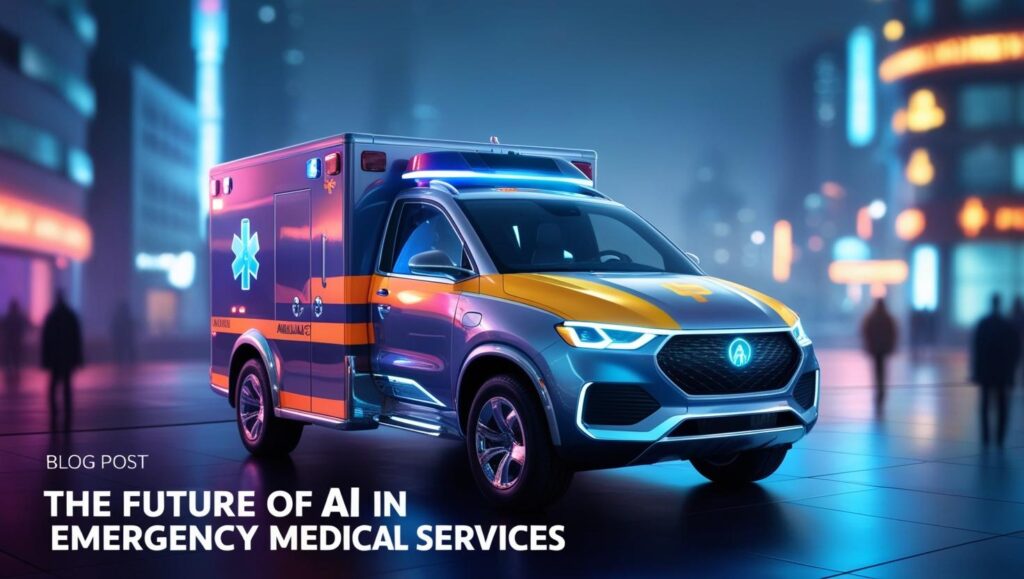Managing training and compliance for EMS agencies is no small task. With evolving protocols, demanding…

The Future of AI in Emergency Medical Services: Transforming Training and Patient Care
Home » 911 e-Learning News » The Future of AI in Emergency Medical Services: Transforming Training and Patient Care

Artificial intelligence (AI) is rapidly changing the landscape of emergency medical services, reshaping how providers train, make decisions, and deliver patient care. As technology advances, AI is becoming an essential tool for EMS professionals, helping to improve response times, streamline training, and enhance overall efficiency. And yes, it even created the image above for this blog!
But AI’s influence doesn’t stop at training—it’s revolutionizing EMS operations in ways that will redefine emergency care in the future.
How AI Is Reshaping EMS Training and Education
EMS training has long relied on in-person lectures, hands-on clinicals, and scenario-based learning. While these methods are effective, they can be time-consuming and challenging for busy providers. AI is addressing these issues by making EMS education more flexible, personalized, and data-driven.
1. Adaptive Learning Platforms
AI-powered adaptive learning adjusts coursework in real-time based on a student’s progress and performance. Instead of a one-size-fits-all approach, AI analyzes strengths and weaknesses to personalize lessons, ensuring providers receive targeted education where they need it most.
2. Virtual Patient Simulations
With AI-driven virtual simulations, EMS professionals can practice real-world scenarios without risk. These simulations provide dynamic patient cases that respond to treatment decisions in real time, mimicking the unpredictability of real emergencies. This enhances critical thinking, clinical judgment, and decision-making skills.
3. Automated Skills Assessment
AI can evaluate student performance using machine learning algorithms and grading skills such as airway management, CPR, and medication administration. This provides immediate feedback, allowing providers to improve in real time without waiting for instructor evaluations.
4. Voice and Chatbot Learning Assistants
AI-powered chatbots and voice assistants are becoming a valuable resource for EMS students, providing instant answers to course-related questions, clarifying difficult concepts, and even guiding learners through practice scenarios.
With online training solutions integrating these AI-driven technologies, EMS education is becoming more accessible, efficient, and personalized.
AI’s Role in EMS Operations and Patient Care
Beyond education, AI is also improving field operations and patient outcomes. From dispatching ambulances more efficiently to assisting in critical decision-making, AI is proving to be a game-changer in emergency medicine.
1. Predictive Analytics for Emergency Response
AI-powered predictive analytics can analyze historical data to identify patterns in 911 call volumes, helping EMS agencies anticipate high-demand periods and strategically position ambulances in areas where they’re most likely to be needed. This reduces response times and improves patient survival rates.
2. AI-Assisted Triage and Diagnosis
EMS providers often make split-second decisions in high-pressure situations. AI-driven decision-support tools can analyze vital signs, patient history, and symptoms in real time to suggest possible diagnoses and treatment options, helping providers make more informed decisions.
3. Real-Time Language Translation for Patient Communication
AI-powered translation apps allow EMS providers to communicate with non-English-speaking patients in real time, ensuring critical information isn’t lost due to language barriers. This improves patient care and reduces the risk of miscommunication during emergencies.
4. Automated Documentation and Reporting
AI-driven voice recognition tools can transcribe patient interactions and automatically generate electronic patient care reports (ePCRs), saving EMS providers valuable time on documentation and reducing errors. This ensures better record-keeping and compliance with regulatory standards.
5. AI-Driven Telemedicine Support
In remote or high-risk situations, AI-powered telemedicine platforms enable EMS providers to consult with physicians in real time. AI can assist by analyzing live patient data and suggesting treatment options, ensuring patients receive the best possible care before arriving at the hospital.
The Future of AI in EMS: What’s Next?
As AI continues to evolve, we can expect even greater advancements in EMS technology. Some future possibilities include:
- AI-Powered Wearable Devices: Smart sensors that monitor vital signs and alert EMS teams to potential medical emergencies before they occur.
- Autonomous Drones for Emergency Response: AI-controlled drones that deliver AEDs (automated external defibrillators) or medical supplies to remote locations faster than ambulances.
- Advanced Robotics in Patient Transport: AI-driven robotic stretchers and transport devices that assist in safely moving patients in complex environments.
AI isn’t replacing EMS providers—it’s enhancing their capabilities. By integrating AI-driven training solutions with real-world emergency response applications, EMS professionals can provide faster, more accurate, and more efficient care.

Related Posts
- Top Challenges EMS Agencies Face with Training Compliance (and How to Solve Them)
- CAPCE-Accredited EMS Training: Why It Matters
If you're an EMS provider or agency looking for CE courses, understanding why CAPCE accreditation…
- Say What?
Are you the one that tends to say "yes" more often than not, and then…
